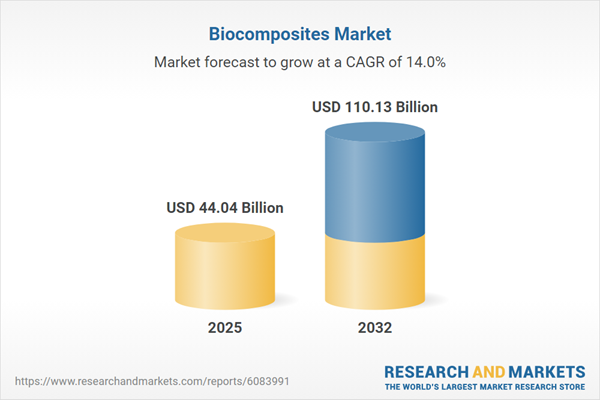Speak directly to the analyst to clarify any post sales queries you may have.
The biocomposites market is entering a rapid growth phase as industries seek practical, sustainable materials that align with evolving environmental standards and the urgent need for reduced resource dependency. This transformation is shaped by increasing regulatory scrutiny and the broad adoption of eco-friendly alternatives tailored to diverse industrial demands.
Market Snapshot: Biocomposites Market Growth Trajectory
The Biocomposites Market registered robust expansion, rising from USD 38.73 billion in 2024 to USD 44.04 billion in 2025, and is projected to continue its momentum at a CAGR of 13.95%, reaching USD 110.13 billion by 2032.
Increased integration in automotive, construction, packaging, and consumer goods, underpinned by a diverse array of fiber reinforcements, is driving this upwards trajectory. Demand has accelerated as organizations prioritize sustainable options to address the limitations of petroleum-based plastics and enhance future resilience across supply networks.Scope & Segmentation
- Reinforcement Types: Encompasses natural fibers such as flax, hemp, jute, and kenaf, as well as wood flour, which deliver unique benefits in mechanical strength, weight reduction, and renewability.
- Applications: Includes automotive components, construction materials, consumer goods, flexible packaging solutions, and rigid packaging formats, reflecting the versatility of biocomposites across high-impact sectors where sustainability and performance are both mission-critical.
- Manufacturing Processes: Covers technologies such as compression molding, extrusion, injection molding, and thermoforming, each offering adaptability for specific product geometries and batch sizes to meet varied production requirements.
- Matrix Types: Incorporates both bio-based polymers (including polyhydroxyalkanoates and polylactic acid) and synthetic polymers (such as polyethylene and polypropylene), enabling customization of physical properties and environmental profiles.
- Forms: Comprises fibers, pellets, profiles, sheets, and films, supporting diverse design approaches and targeted end-use performance.
- Regional Analysis: Considers major markets in the Americas (United States, Canada, Mexico, Brazil, Argentina, Chile, Colombia, Peru), Europe (United Kingdom, Germany, France, Russia, Italy, Spain, Netherlands, Sweden, Poland, Switzerland), Middle East (United Arab Emirates, Saudi Arabia, Qatar, Turkey, Israel), Africa (South Africa, Nigeria, Egypt, Kenya), and Asia-Pacific (China, India, Japan, Australia, South Korea, Indonesia, Thailand, Malaysia, Singapore, Taiwan), ensuring comprehensive global perspective on growth levers and localized challenges.
- Companies Profiled: Features industry leaders such as BASF SE, Dow Inc., DuPont de Nemours, Inc., Arkema S.A., Mitsubishi Chemical Holdings Corporation, Koninklijke DSM N.V., Eastman Chemical Company, Trex Company, Inc., UPM-Kymmene Corporation, and Stora Enso Oyj.
Key Takeaways for Senior Decision-Makers
- Intensifying regulatory measures and preference shifts among end-users promote steady adoption of biocomposite solutions in automotive, construction, and packaging industries.
- Ongoing material innovation, such as integrating flax, hemp, and kenaf fibers with high-performance polymers, achieves sustainability while ensuring required mechanical attributes.
- Advances in technologies like extrusion and molding streamline integration of biocomposites into current manufacturing processes, supporting cost efficiency and scale.
- Strategic collaborations among OEMs, material innovators, and research bodies expand new product potential and enable greater market penetration.
- Lifecycle assessment data and digital traceability have become vital for meeting regulatory and customer expectations regarding environmental impact transparency and compliance.
- Localized demand encourages tailored incentives, supporting innovation clusters and more robust domestic supply chains in both established and emerging regions.
Tariff Impact & Strategic Sourcing Considerations
Recent adjustments to United States tariffs on imported biocomposite feedstocks have created new complexities for global supply chains. In response, many organizations are adjusting sourcing strategies by strengthening domestic supplier networks, seeking alternative reinforcements, and negotiating long-term agreements. These shifts place greater focus on process optimization, raw material substitution, and investment in local processing capabilities. Enhanced traceability is now prioritized, with companies building closer regional partnerships to minimize risk from external disruptions.
Biocomposites Market: Methodology & Data Sources
This report uses a multi-layered analytic approach, incorporating expert interviews, technical literature, and in-depth market mapping. Validation of material flows and technology roadmaps is achieved through triangulating independent data sources and scenario analysis, ensuring robust insight into regulatory and market-driving forces.
Why This Report Matters
- Supports effective scenario planning and responsive sourcing strategies to adapt to changing tariffs and regulatory landscapes across international supply networks.
- Informs product development by mapping new fiber reinforcements, technology advances, and application case studies for targeted sectoral adoption.
- Guides forward-looking investment choices by charting technology trends, alliance structures, and compliance pathways in key regional markets.
Conclusion
Biocomposites represent a forward-looking solution, reinforcing industry ambitions for sustainability, compliance, and adaptive growth. Equipped with actionable intelligence, decision-makers are well positioned to navigate shifting market conditions and harness innovative materials to sustain competitive advantage.
Table of Contents
3. Executive Summary
4. Market Overview
7. Cumulative Impact of Artificial Intelligence 2025
List of Figures
Companies Mentioned
The companies profiled in this Biocomposites market report include:- BASF SE
- Dow Inc.
- DuPont de Nemours, Inc.
- Arkema S.A.
- Mitsubishi Chemical Holdings Corporation
- Koninklijke DSM N.V.
- Eastman Chemical Company
- Trex Company, Inc.
- UPM-Kymmene Corporation
- Stora Enso Oyj
Table Information
| Report Attribute | Details |
|---|---|
| No. of Pages | 194 |
| Published | November 2025 |
| Forecast Period | 2025 - 2032 |
| Estimated Market Value ( USD | $ 44.04 Billion |
| Forecasted Market Value ( USD | $ 110.13 Billion |
| Compound Annual Growth Rate | 13.9% |
| Regions Covered | Global |
| No. of Companies Mentioned | 11 |









